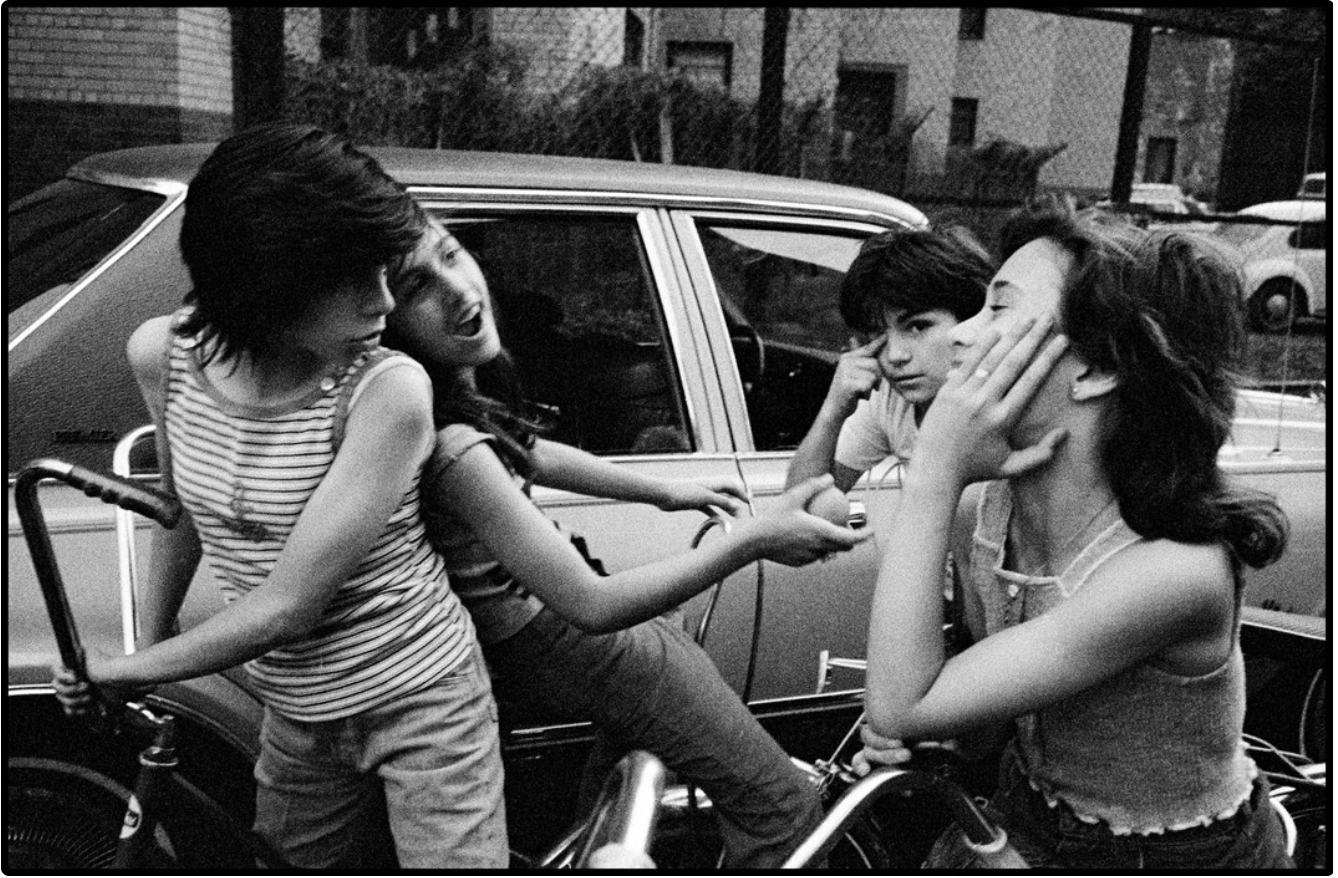
RE:CYCLE
The Ubiquitous Bike
October 8 - December 31 2023*
* Bikes on view October 8 - December 10
*Fine art on view through December 31st
Opening Reception: Saturday, October 7th | 6:00 - 7:30 PM
Dexter Boneshaker (replica), 1869. Cast Iron. Courtesy of The Bicycle Museum of America, New Bremen, Ohio.1997.003.
Background image: Dee, JoJo, Frankie and Lisa after school, Prince Street, NY, 1976. Susan Meiselas.
OVERVIEW
Continuing The Church’s series of exhibitions exploring the intersection of material culture and modern and contemporary art, we are pleased to present this show in three parts:
20 bicycles selected by Eric Fischl and Ryan Long from the collection of The Bicycle Museum of America, New Bremen, Ohio, along with artworks by Jarbas Lopes and Studio Drift
A selection of over 25 photographs curated by Mark Lubell, photo scholar and former Executive Director of the International Center of Photography in New York City, and Jennifer Tripp, photo expert formerly with Magnum Photos
2 contemporary art videos by Bas Jan Ader and Bari Kumar selected by Sara Cochran
The bikes from The Bicycle Museum of America focus on the engineering and design innovations that have marked the vehicle’s development. Ranging from the 19th century chainless Velocipede (aka the "Boneshaker”) and the High Wheel (aka the “Penny-farthing”) to the Safety Bicycle (so-called because the wheels were of equal size and the rider was seated further back on the bike and less likely to be thrown over the handlebars) to Cruisers and Racing bikes. They illustrate the centrality of the issues of comfort, design, and speed to this ongoing engineering obsession.
The photographs in the exhibition explore the lives of people around the world over the past century with the bicycle as a common denominator. An evolving icon of our age, the subject of people on their bicycles has fascinated a diverse group of photographers and artists.
The object and its uses have changed our lives. As Susan B. Anthony stated: “Bicycling… has done more to emancipate women than anything else in the world. It gives women a feeling of freedom and self-reliance.” As these artworks illustrate, that sense of agency and autonomy are available to all of us old or young, regardless of gender or geographic location when we get on a bike and ride.
This exhibition was supported in part by the generosity of Jim Dicke II of Crown Equipment Corporation, and founder of The Bicycle Museum of America.
Explore the exhibition Below!
THE BICYCLES
-
The Bicycle Museum of America has nearly 150 bicycles on display in its galleries and 800 in its collection. Its guided and self-guided tours allow visitors to explore the history of the bicycle and how it helped shape the American landscape through innovation and design. The Museum’s mission is to provide an understanding through interpretation, social relevance, and the dissemination of information on bicycles and cycling on a global and historical platform. Visit the Bicycle Museum’s Website for more information.
-
Ryan Long graduated from The Ohio State University with a degree in North American History. His position at the Bicycle Museum of America allows him to indulge his passion for preserving human history, as he believes history defines and gives context to our present. Through its collection and scholarship, the Bicycle Museum offers a unique opportunity to preserve not only a litany of historic bicycles but the history behind them and the manufacturers that created them.
THE PHOTOGRAPHY
-
Dawoud Bey, A. Aubrey Bodine, Robert Capa, Henri Cartier-Bresson, Philippe Cheng, Elaine Constantine, William Eggelston, Elliott Erwitt, Loenard Freed, Burt Glinn, Jim Goldberg, Thomas Hoepker, Evelyn Hofer, Seydou Keïta, Don Lenzer, Vivian Maier, Costa Manos, Steve McCurry, Susan Meiselas, Inge Morath, Lindsay Morris, Rodney Smith, Ron Terner, Alex Webb, Bruce Weber
-
Mark Lubell served as the Executive Director of the International Center of Photography (ICP) from 2013-2021. Under his leadership, ICP built its new building on the Lower East Side, reuniting its school and museum. Here it launched breakthrough exhibitions, expanded the school’s online offerings, and continued its commitment to community and public programs. From 2003-2011, Lubell was Director of Magnum Photos, where he worked with its world-renowned photographers to transform the legendary agency. American Photo named Lubell “Innovator of the Year” in 2007 for his pioneering approach to multimedia and online communities. Prior to Magnum, Lubell was Chief Operating Officer of "Here is New York: A Democracy of Photographs," which was formed in the aftermath of the events of September 11, 2001. Lubell currently divides his time between Sag Harbor and New York City.
-
Jennifer Tripp, an independent curator and advisor, is the founder of Tripp Projects where she curates exhibitions and assists in the acquisition of photography for private and public collections. Previously, Tripp was the Assistant Director of Craig Krull Gallery in Santa Monica, CA, before joining Magnum Photos New York as Director of Print Sales where she built strategic partnerships and conceived of exhibitions from Magnum’s vast archive. She received her BFA in Photography from SCAD (Savannah College of Art & Design) and continues to collaborate with leading contemporary artists, advisors, and cultural institutions internationally.
THE VISUAL ART
-
Bas Jan Ader
Fall II, Amsterdam, 1971
Black and white film transferred to video, 19 seconds
The Estate of Bas Jan Ader/ The Artist Rights Society (ARS), New York. Courtesy Meliksetian/ Briggs, Los AngelesBas Jan Ader’s series, Fall, includes two films and a series of photographic pieces, which encapsulate the frailty and vulnerability at the heart of much of the artist’s work. Fall I, Los Angeles (1970), is a short film depicting the artist falling off a chair on the roof of his house and rolling down its slope to the ground. Fall II, Amsterdam (1971), shows the view across a canal in Amsterdam as the artist, riding on a bicycle, comes around a corner and down the street before suddenly losing his balance, disappears into the water with a large splash. Both films end abruptly after the moment of contact with the ground or water.
-
Bari Kumar
Army of Forgotten Souls, 2005. Video, 3 mins.
Shows with Bose Pacia Gallery, New YorkBari Kumar’s video is about progression and propulsion. It is cantered on the back of a rickshaw cyclist in Kumar’s birthplace of Nellore, India, and is shot from the privileged perspective of the passenger. Bound to their rickshaws all day and night and powered solely by their own physical strength, these men were formerly the primary mode of transportation to the area. However, with the progress of urban development came automation, threatening the meagre livelihood of these labourers. Working in the scorching heat and struggling to keep up with the changing times, the abstracted image of movement of the muscles in the cyclist’s back is touching as he is overtaken by a motorised rickshaw. Made with music from Transglobal Underground, the work is a homage to the rickshaw wallah—a melancholic celebration of the end of an era.
-
Studio Drift’s Materialism series is an ongoing research project that explores the everyday objects around us. The artists reduce these common things -- bikes, light bulbs, water bottles, vacuum cleaners, and cars -- to the exact quantity of specific raw materials they contain and show these materials in the form of rectangular blocks. This process ‘de-produces’ the product, deconstructing familiar things about which we tend only to consider their function and clarifies how much of the matter within them is extracted from the earth. Control over raw materials is at the heart of numerous geopolitical tensions and, while people might like to think of these as a matter for politicians, everyone is implicated. Everything that is bought and consumed has an impact, reinforcing complex systems of resource extraction, labor, manufacturing, distribution, waste, and ecological destruction.

